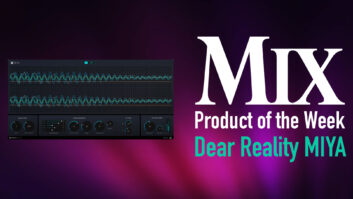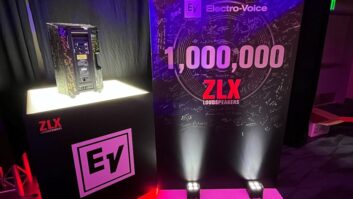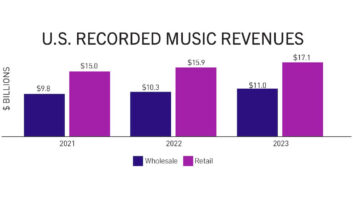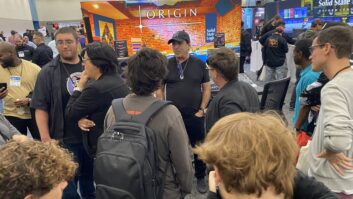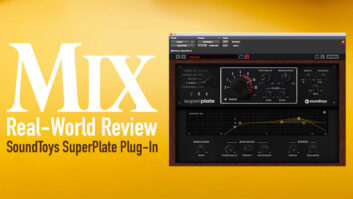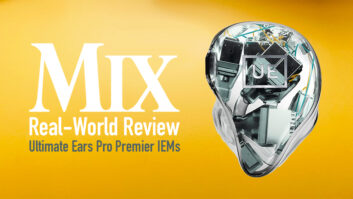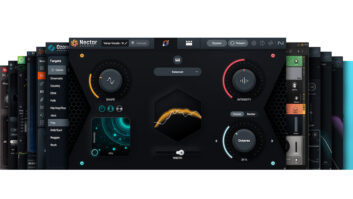From April 17-22, 2004, nearly 98,000 audio, video, film and broadcast pros went to Las Vegas for the annual National Association of Broadcasters Convention. For five days, hardy attendees endured jam-packed exhibit halls, interminable taxi lines and the pleasure of paying $225/night for a hotel room that just days before was $59. However, for those seeking the latest technologies, the quest was worthwhile. On the video side, the hot topics were affordable HD production systems (such as Apple’s Final Cut Pro HD) and new tapeless ENG cameras using solid-state memory cards (such as Panasonic’s DVCPRO P2 format). On the audio side, we found plenty of cool goodies. Here are a few.
CONSOLES: BIG NEWS!
In past years, the talk at NAB centered on desktop video, HDTV and DVD authoring. To be sure, these were all present, but this time, the buzz was consoles: big consoles.
During the show, Digidesign‘s (www.digidesign.com) booth in the Avid pavilion was packed with people checking out its new large-scale ICON mixing environment for Pro Tools, which was previewed in Mix’s April issue. Mindful of the growing DAW controller market, Solid State Logic (www.solid-state-logic.com) unveiled its AWS 900, a 24-channel desk that uses the same components as its XL 9000 K Series consoles. The 8-bus, $85,000 list board is to be sold through GC Pro dealers and includes control of various DAW platforms and plug-ins, as well as a serious analog console with 24 mic preamps, switchable E/G Series 4-band parametric EQ, assignable dynamics, moving faders and more. (See the “Technology Spotlight” on page 118 for more details.)
Mixing film? AMS Neve‘s (www.ams-neve.com) updated, speed-supercharged DFC Gemini pairs its top digital film console with the new CineFile™ dubber to create an integrated edit/mix system for high-end facilities. A year ago, DiGiCo (www.digiconsoles.com) showed the mid-priced Soundtracs DS-00 scalable, medium- to large-format digital console. Now, it’s delivering the specialized FP-00 film section option, giving users true film-style control with dedicated paddle switching (recall of all paddle functions during the session). Harrison’s (www.glw.com) MPC-3D updates the original MPC, with 8-band EQ per strip, integral TFT screens displaying the multi-operator IKIS automation platform with 10 EQ shapes and expanded dynamics control selectable from standard pointing devices or optional TouchPen interface, 40-bit digital processing and up to 768 channels per digital core.
Studer‘s (www.studer.ch) new Vista 8 console combines the broadcast features of its Vista 6 with the dynamic automation of the Vista 7. Vista 8’s Control Bay center section — housing a Vistonics screen with 40 rotary encoders, switches and 12 faders — can control inputs, outputs or groups, and general and global functions, and provides assignable high-res metering. New versions of Euphonix‘s (www.euphonix.com) flagship 5-B digital broadcast desk allows 96 channels/24 buses on a single mixer core. The new 5-BP supports up to 310 assignable channels with mix automation, allowing one system to handle both on-air and audio post chores. Also new for System 5 is a Soundmaster (www.soundmaster.com) ION option for sync and motion control of up to 16 devices/transports.
After three decades of supplying high-end broadcast gear in Europe, Lawo (www.lawo.ca) has established a North American office and is targeting the U.S. market with the mc2 66, a mid-priced digital console that merges an ergonomic control surface with a central core/routing matrix of up to 192 fully equipped channels and 144 summing buses. It comes in 48×8, 56×8 and 64×8 fader configurations with a lean Linux control operating system, a 3,072 I/O matrix and 7.1 surround support. Decidedly more affordable, Mackie‘s (www.mackie.com) dXb•400 post and broadcast digital console features a 96×96-channel I/O matrix, 72 96kHz channels with DSP (36 at 192 kHz), 24 mic buses with dynamics, full 7.1 surround monitoring with fold-down function, mix-minus busing, onboard Universal Audio LA-2A and 1176 compression and much more.
DAWS: STILL HOT!
The PCM-H64, SADiE‘s (www.sadie.com) high-end multitrack DAW for post and music, is built around the new TNG3 processor card, offering real-time editing, EQ, dynamics control and full surround mixing of 64 channels of 48kHz/24-bit audio (or up to 16 channels at 192 kHz). I/O options include analog, digital and MADI at standard or higher sample rates. The system is scalable and can carry up to four cards, offering 12 Gflops of raw audio DSP processing power in a single computer.
Fairlight (www.fairlightau.com) announced QDC-XT, a powerful new engine for its DREAM workstations and Constellation digital console, as well as Version 3.2 software and a Virtual Studio Runner feature set that speeds communication, networked file exchange and workflow within the studio. Also, Fairlight’s Plug-In Manager 6 hardware opens the system to using a suite of 80 low-latency VST plug-ins. You can’t call them just a “workstation company” anymore.
Adobe‘s (www.adobe.com) Audition 1.5 is a DAW optimized for video, but is also impressive as an audio-only production tool. The Windows-only app offers ReWire and VST plug-in support, sampling rates up to 10 MHz, 128 stereo tracks, 500 royalty-free production loops, pitch correction and clip time-stretching. Other features include unique offline panning, extensive MIDI support and an integrated CD burner.
The HR Series of PCX sound cards from Digigram (www.digigram.com) feature 24-bit/192kHz converters, eight input/outputs, sample rate conversion and greater processing power (including extra DSP for future developments). The cards can be purchased with either digital (PCX881HR) or analog (PCX882HR) I/Os.
Apogee‘s (www.apogeedigital.com) small but impressive X-Series-HD card piggybacks on its Rosetta 800 8-channel AD/DA interface, offering direct connection to Pro Tools|HD Core or Accel cards; in essence, tricking the system into thinking it’s a Digi interface. The $599 card includes an expansion port to daisychain multiple Apogee devices. The setup also allows Rosetta to be used next to Digidesign’s 96 I/O, 192 I/O and Prism’s Dream ADA-8.
SURPRISES BIG AND SMALL
As reported in the April Mix, Dolby (www.dolby.com) debuted Dolby Digital Plus, an enhanced AC-3 audio compression scheme designed to pack more audio into ever-smaller data pipelines. Just before NAB, the Advanced Television Systems Committee (ATSC) elevated the protocol to Candidate Standard status as part of its work on next-generation broadcast and transport systems. The codec wars have been heating up as of late, with SRS, Microsoft, Telos and DTS all muscling in on delivery for broadcast, DVD and the Internet.
Holophone‘s (www.holophone.com) H2-PRO is its next-generation multichannel surround microphone. Housed in a tough 7.5×5.7-inch, egg-shaped body, the mic has inset condenser capsules (5.1, plus top and center rear) for capturing discrete 5.1, 6.1 and 7.1 sounds. The feeds terminate in standard XLRs for connection to your mixer, preamps or recorder.
DK Audio (www.dk-audio.com) taught its old dog a new trick with a remote sensing platform for its modular MSD600M family of audio meters. This 19-inch frame separates the I/O and measurement hardware from the user interface, connected via a Cat-5 umbilical. Freed from encumbering cables, the UI can be mounted freely in any position, even in tight spaces.
DPA (www.dpamicrophones.com) generated a lot of interest with the debut of WindPac 4000, an ultralight (9-ounce), water-resistant windshield. The zeppelin-shaped device combines a universal shock-mount that holds up to two mics and a collapsible, flat-folding windshield. The fabric blocks wind noise in gusts up to 70 mph while allowing accurate sound reproduction and audio transparency.
The first name in location recorders, Nagra (www.nagra.com) demoed ARES-5B, a compact field recorder that stores stereo signals to 16-bit/48kHz Broadcast .WAV files on PCMCIA or Compact Flash cards. The $2,000 deck runs on a Lithium Ion pack or AA cell, and has balanced analog I/Os and a USB output.
There was more at NAB, so watch our upcoming new products sections for more innovations from the show. Meanwhile, the convention returns to Las Vegas from April 16-21, 2005. Book those hotels now!
